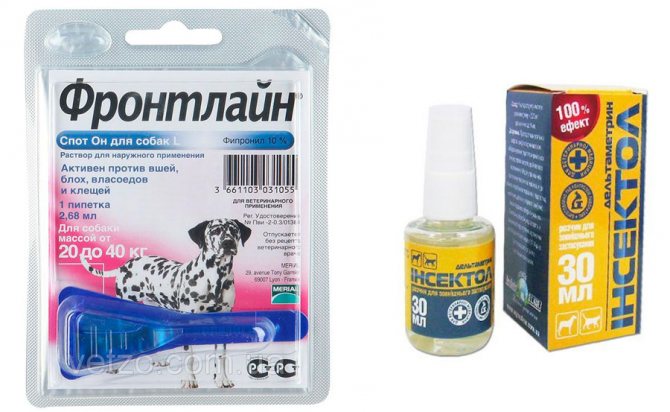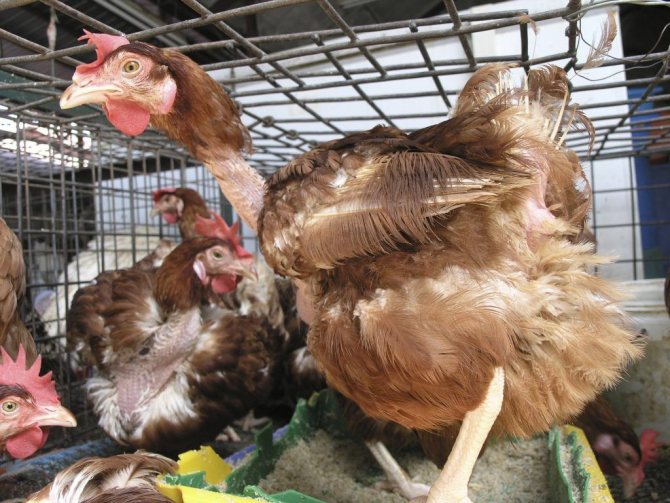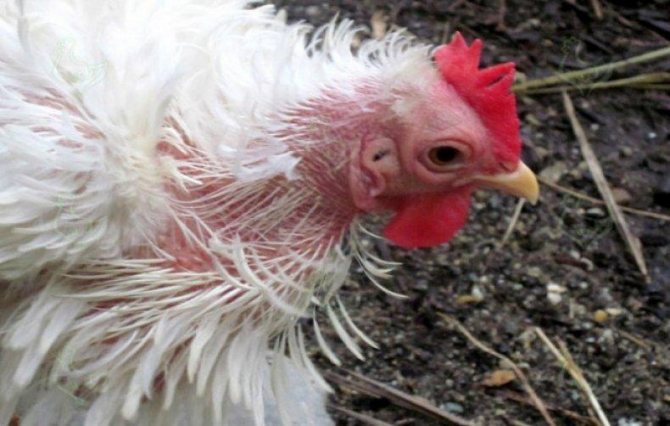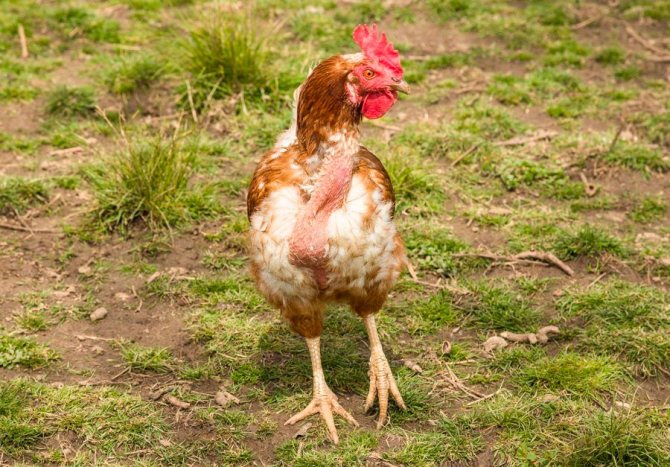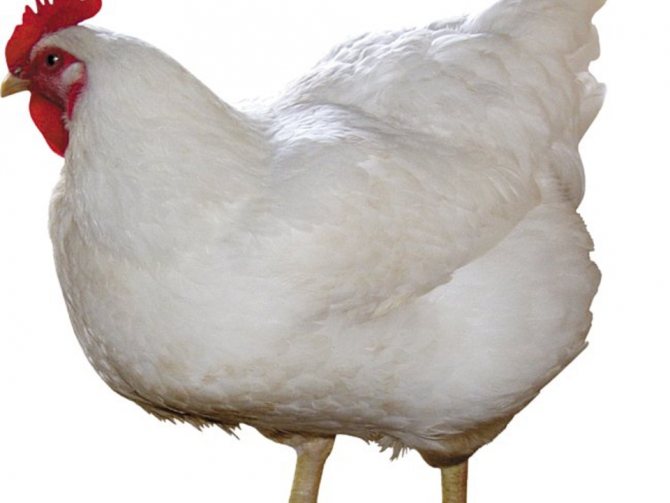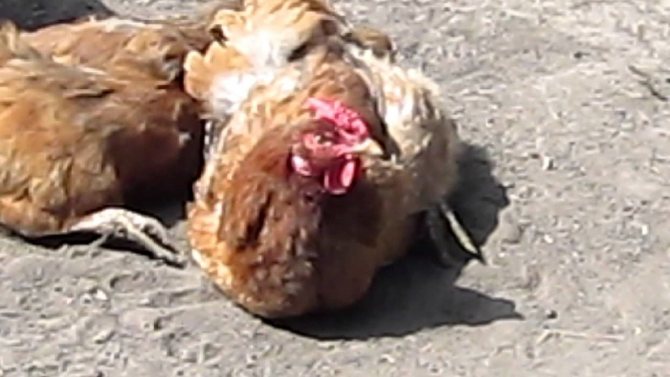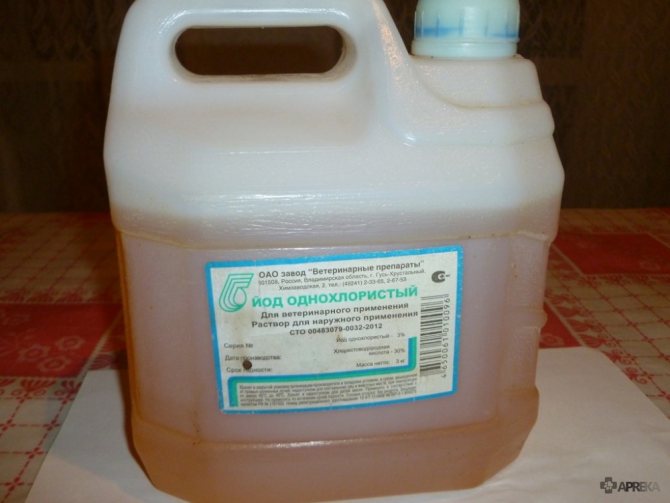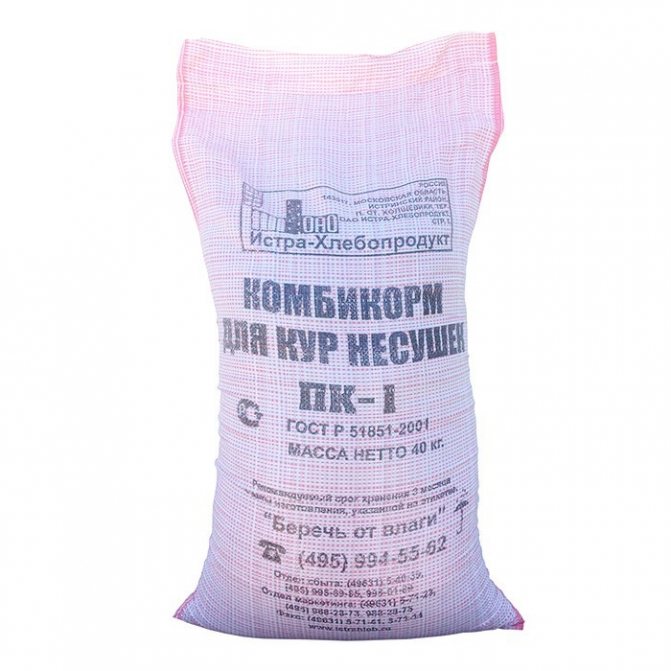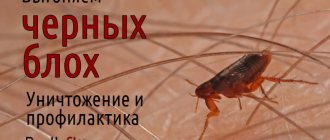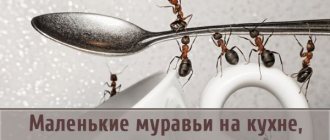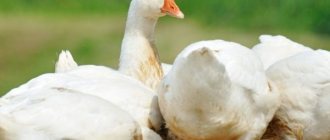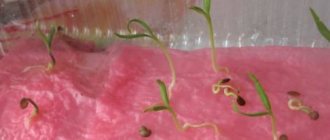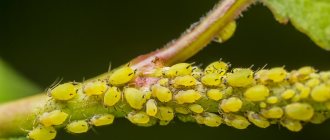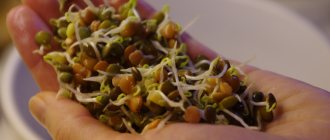»Poultry» Chickens »Treatment of feather-eating in chickens with folk remedies
0
585
Article rating
The reason for the intense loss of feathers in birds, and sometimes pecking, is a parasitic infection - mallophagosis (nar. Peroed). Feeding in chickens causes a decrease in immunity, weight loss and a drop in egg production. This can lead to mortality among young animals.

The cause of feather loss in chickens is a feather eater.
Who are the feather-eaters


Let's take a look at what this parasite looks like. It is a small tick, resembling a louse, with a narrow body no more than 2 mm long. The insect is light brown, almost yellow in color.
The parasite has 6 paws with a pair of claws on each. They are designed so that the feather eater can easily cling to the bird's body and just as easily move along its surface. Basically, the feather-eater appears due to unsanitary conditions in the chicken coop. Late cleaning, rot, and debris are excellent breeding grounds for this parasite.
Important! Charcoal is an excellent antiseptic, which is why it must be present in a chicken coop. You can also use seashells or chalk. The substances are placed in a small container and installed in the poultry house, which saves layers from annoying parasites.
Active reproduction of insects begins from the moment they hit the bird's body. They eat down, feather base and epidermis. Parasites are very hardy, they can withstand sudden changes in temperature and lack of nutrition.
Causes of the disease
The main reasons for the appearance of a feather-eating may be the following factors:
- If the room in which the chickens live has a small area. Often this parasite occurs in a cramped chicken coop, where a large number of chickens live.
- Poor hygiene conditions. If sanitary standards are not observed in the place where the poultry is kept. Typically, a feather-eating occurs when the containment room is constantly dirty, the feeders are not cleaned.
- The lack of a container with wood ash, shellfish or chalk in the hen house.
Infection routes
The appearance of downy eaters in a bird is a disease called mallophagosis. It has no age restrictions and can occur in both young and old chickens. Moreover, it is spreading rapidly. The appearance of one infected individual entails the infection of the entire livestock in a week.
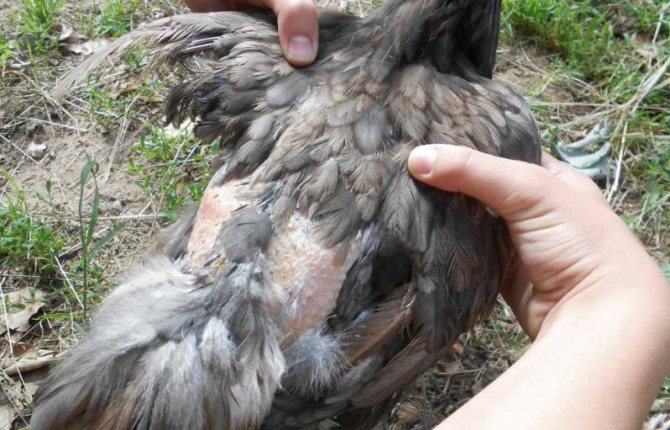

In order to avoid an unpleasant ailment in your farm and protect it from parasites, it is important to understand exactly what ways feather eaters can get into the poultry house:
- A healthy bird can receive an ailment as a "reward" by taking the same dust baths with infected individuals.
- Wild birds, which are their carriers, can also bring feather eaters into the chicken coop.
- Keeping sick and healthy layers together, using the same perches, nests, placing such birds in one cage.
- People can also bring these mites on their clothes and shoes if they were in a room where the feather eater already lives.
- Roosters are often the source of infection for chickens, as they are less likely to clean their feathers and are less careful than laying hens.
Did you know? During its life, one female feather-eater lays about 120 thousand eggs. This process is cyclical and almost never stops. And one chicken can become a habitat for 10 thousand parasites at the same time.
During an increase in the activity of chickens, the risk of their infection increases greatly. These periods are in spring and autumn. There are other situations that provoke an outbreak of the disease:
- low level of poultry, excessive dampness and dirt, which provokes the onset of infection;
- nutrition of chickens, poor in vitamins and minerals, which leads to a weakening of the immunity and the body of birds as a whole;
- small size of the house, which leads to a high concentration of birds.
Diagnostics
A parasitic infection called mallophagosis is identified by a receding hairline on the back. But bald spots do not always indicate the presence of a feather eater. They also appear due to a lack of vitamins, dry stale air, high humidity in the chicken coop. Baldness also occurs during shedding.
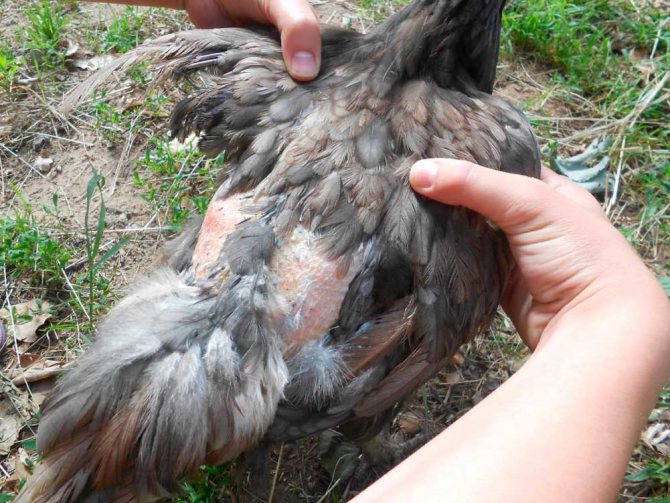

Therefore, for the diagnosis, it is necessary to take into account other symptoms that are characteristic of mallophagosis.
Symptoms of the appearance
By the way the bird behaves, it is possible to determine the presence of the parasite. The appearance of peroed will surely make itself felt by a number of signs that are strikingly different from other diseases:
- the bird is constantly scratching and striving to pull out feathers;
- baldness is observed in places, and holes form in place of the fallen feathers;
- plumage is damaged at the base;
- birds are very nervous, they constantly clean their plumage;
- the growth of young individuals slows down, adult chickens slowly gain weight, as they lose their appetite;
- chickens stop laying.
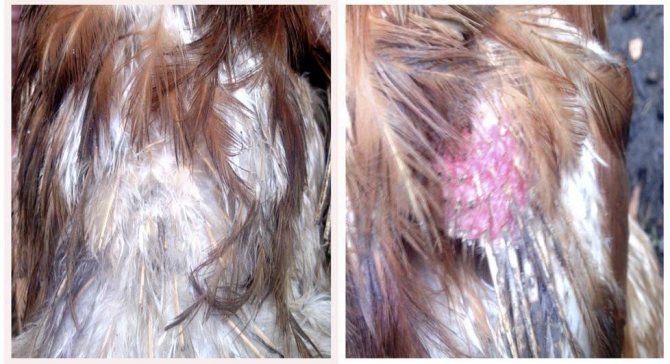

If you do not pay attention to the abnormal behavior of birds for a long time, this can lead to a decrease in their productivity. In addition, laying hens, pecking the skin, form wounds that fester over time.
Pus and inflammation in wounds are very dangerous. If untreated and delayed getting rid of parasites, this can lead to the death of the laying hen.
Fight
Treatment of lice in chickens consists in treating the bird with insecticides. It is better to use drug solutions by spraying them on the bird from a garden sprayer. The plumage should be evenly wetted.
Powders can also be used. They will have to be rubbed into the plumage of each chicken personally, while observing the recommended dosage. Avoid getting the medicine in the eyes and nose if possible.
With the cage keeping, chickens are treated directly in the cages, with the floor, they are sprayed in the dark on the perches.
Lice treatment of chickens should be carried out twice, since insecticides do not kill the eggs of the parasites. In the warm season, the interval is 9-12 days, in the cold season - 12-16 days.
Harm and danger
If we talk about the dangers of this tick for the health of the chicken, then the main damage it can inflict on the productivity of these birds. Under the influence of feather-eating, the chicken's body is greatly weakened, unable to function normally. The egg production of birds is reduced by an average of 10%. Chicks grow much slower than usual, while their sexual development is greatly slowed down and maturity occurs much later.
Decorative breeds suffer primarily aesthetically, since the structure of the plumage is disturbed, and baldness appears. Affected feathers fade.
Learn how to get rid of worms in chickens.
Unprotected skin areas appear on the chicken's body, which are easily affected by infections. The skin becomes covered with wounds, which accumulate dirt and create a favorable environment for the reproduction of microorganisms. As a result, in addition to being affected by a feather-eating, the laying hen begins to get sick with other, no less dangerous, diseases.
How to deal with feather eaters
Sensing the parasite, the birds try to heal themselves on their own. But no matter how hard they try, it is impossible to rid chickens of ticks without human intervention.
It is necessary to start the fight against feather eaters from the moment the first signs of their appearance in the chicken coop are discovered.An infected individual must be immediately removed from the rest, and healthy chickens must be treated with insecticides. The poultry house is thoroughly cleaned and disinfected; in addition, the surfaces can be treated with a blowtorch or steam.
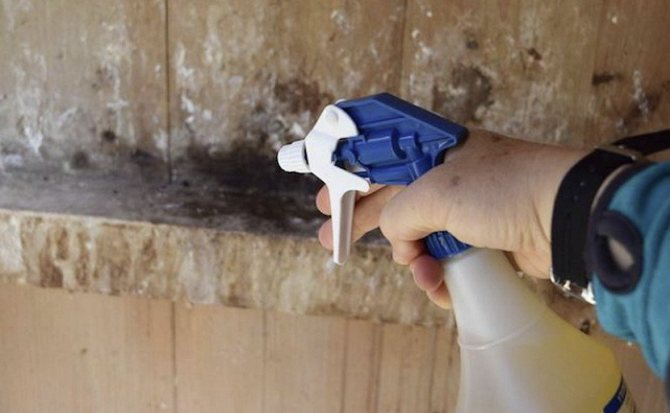

In parallel with preventive work among healthy livestock, medical measures are carried out for sick birds. In order to get rid of parasites, chemicals or folk remedies are often used.
Did you know? Feathering is dangerous not only for birds, but also for people. This tick can be a carrier of typhoid or salmonellosis, as well as cause allergies. His bites cause severe itching, which can lead to swelling.
Chemicals
Using chemicals for feather eating is a very effective way. In every veterinary pharmacy, you can find a lot of parasite remedies. These poisons affect the nervous system of pests, which leads to their rapid death, while not affecting the bird's body.


For the use of drugs to be more effective, the following rules must be observed:
- Preparations in the form of drops should be applied to the withers so that the chicken cannot reach the feathers and get poisoned. Ticks die in a couple of minutes, so tying the beak can be another way to save the chicken.
- Sprays are sprayed at a distance of 15 cm. You can protect the bird's eyes from getting medicine by covering its head with a cloth.
- The action of all drugs is aimed at destroying adult insects, but does not affect their eggs. In this regard, the procedure for killing ticks must be repeated after 7-10 days. If you ignore it, then in two weeks the chicken will again suffer from parasites.
Important! Chemicals are too toxic and not suitable for chickens, therefore, for their fragile organisms, it is worth choosing more gentle products.
Insecticides
As for such drugs, now the store shelves are full of various products, but the most popular and affordable are the following:
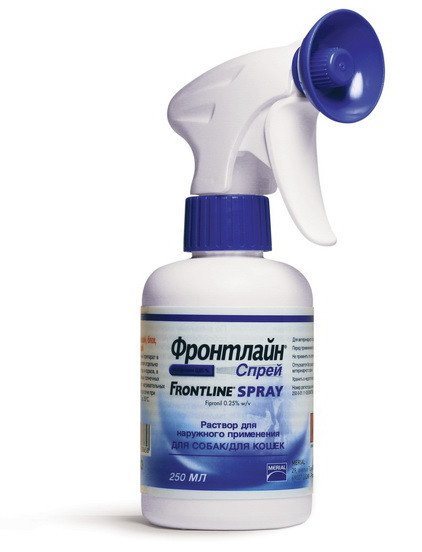

- "Nuda" Is a human spray for the removal of lice. It has an equally effective effect on birds. Its price is quite high, and therefore it is most often used to process a small number of livestock.
- "Butox" - well displays various types of insects. Produced in ampoules. Dilute the product in the ratio of 1 ml of medication to 1.5 liters of water. It is applied to feathers by spraying, it is also used for treating poultry houses.
- Front Line - sold both in the form of drops and in the form of a spray. Harmful only to adult ticks. Subsequent processing is carried out after a week.
- "Insectol" - using this tool, the chicken is treated with the areas under the tail and wings, spraying the medication in an amount of 0.4 ml until the feather is slightly moistened.
- "Arpalit" - ready-made spray for the complete treatment of poultry, which will protect the hen from further infection.
Disinfectants
Disinfection of birds is required when feather eats appear. For the extermination of ticks, conventional means will not help; the desired effect can be achieved only thanks to those drugs that react in combination with water:
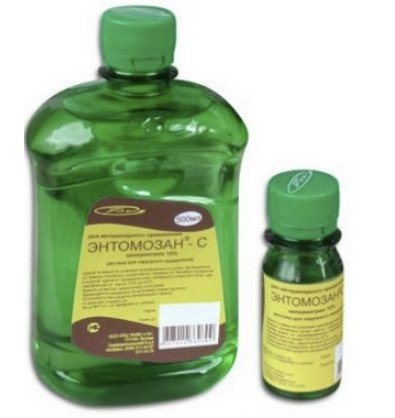

- "Butox" - ampoule preparation for ticks and other parasitic insects. To process one chicken, you will need one ampoule. The drug penetrates the skin and is excreted from the body through the digestive system, which has a complex effect on a number of parasites. Diluted with water in a 1: 1 ratio.
- "Entomozan" - used for processing chickens. Before carrying out the procedure, collect all the eggs in the hen house, and then irrigate the birds with a solution of the drug and water (5 ml of "Entomozan" per 1 liter of water). Re-processing is carried out after 9 days.
- "Neostomosan" - the drug is used in the form of an emulsion. It is formed as a result of the reaction of medication and water.For chickens, it will be enough to mix 1.5 ml of the solution with 10 liters of water. The liquid is poured into a spray bottle and sprayed on the bird.
- "Tsifox" - specific areas of mite accumulation are treated with this drug. The solution is prepared at the rate of 10 ml of the drug per 5 liters of water. After 12 hours from the time of treatment, the preparation must be washed off with a damp cloth and soapy water.
Repellents
There are also a number of drugs that do not have a lethal effect on parasites, but a deterrent. This is a fairly effective prevention for healthy chickens, especially if an infected individual has already entered the population. The most used to eliminate the disease are the following drugs:
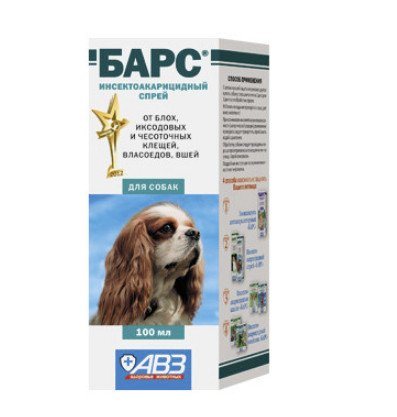

- Front Line - used as a drug against ticks in dogs, but also suitable for poultry. Quite an effective remedy and at the same time non-toxic. The drug is applied to the withers. Its action lasts for several weeks.
- "Leopard" - it is used to destroy various types of parasites, not only in animals, but also in birds. The product should be applied with a pipette on the bird's neck, the recommended dose is 1.4 ml. With the help of this tool, the roost is also treated from pests by spraying a medication.
- "Vitomax" - produced in the form of a spray, has a low cost. It is better to spray the product starting from the tail at a distance of 30 cm until the feathers are slightly moistened. The spray should penetrate your skin, but be careful not to get it in your eyes.
Folk remedies
The abundance of chemicals allows you to quickly get rid of the peroed, although they can be abandoned, since the pest can be removed using more environmentally friendly, and most importantly, cheaper means.
Herbs
In our fields and gardens there are a lot of all kinds of herbs that can save the chicken coop from feather eaters. The most repellent plants for these mites are wormwood, chamomile, tansy and wild rosemary. All this herbs are dried and ground, after which the powder is scattered on the bedding. This will serve as an excellent prophylactic against chicken fleas.
Another way to get rid of ticks is powder from barnyard and hellebore branches. This mixture is showered on the bird, which helps to get rid of the parasites of an already infected chicken. But this agent carries some danger for weakened chickens, in this case it is necessary to dilute the agent with water (2 g per 0.5 l).
Decoctions and infusions
Decoctions of herbs can be treated no less effectively than medicines.
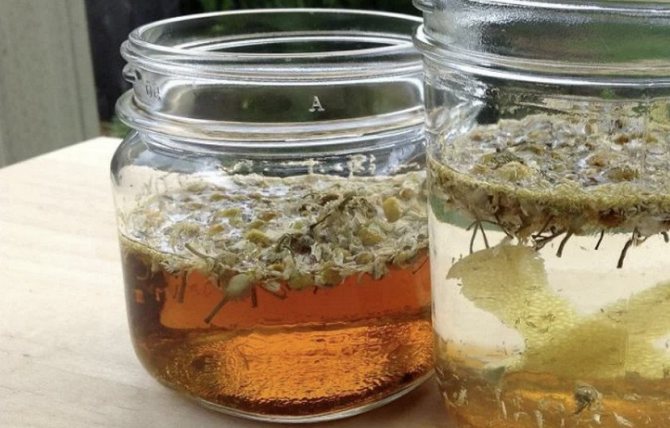

So, for example, chamomile infusion is brewed like a strong tea, and this remedy is rubbed into the affected skin for a week. You can also use this method to treat ailment in chickens.
It is also recommended to brew a solution of tansy and wormwood, which is then used to wash the shelves, walls, feeders and drinkers in the poultry house. To do this, you need to brew one of the plants in boiling water in a 1: 1 ratio and let it brew overnight.
Ash
Ash has proven itself very well in the fight against chicken fleas. Its mixture with sand removes parasites very quickly.
In order to prepare this product, you will need ash and sand in equal proportions. These ingredients are mixed and placed in a container that is installed at the entrance to the chicken coop. It is better that there are several such baths, then it will be easier for the layers to swim without interfering with each other.
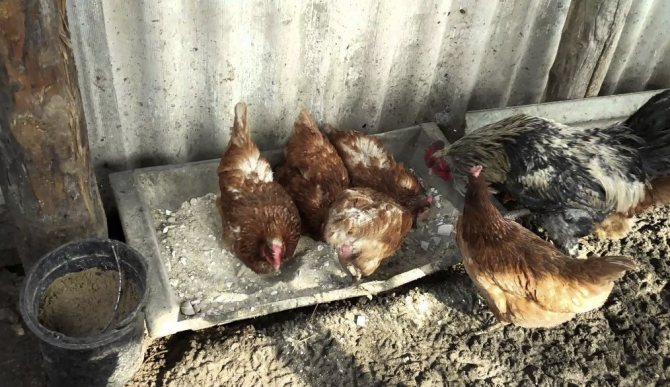

Insects do not tolerate such procedures and die or flee.
You can also make a kind of cream from ash by adding vinegar or kerosene to it. With this medicine, the chicken is lubricated and left until the effect occurs. Air access for parasites is blocked and they die. But this procedure can only be done with adult chickens.
Mallophagous biology
Chicken lice are small wingless insects. They have a flat, rounded or elongated segmented body of yellow-brown color with dark stripes and spots. The head is wider than the body and has small antennae. The size of malofagov is from 1.5 to 2 mm.Three pairs of legs end in tenacious claws with which the parasite is fixed on the host's body. The insect also uses its jaws for this purpose.
The downy eaters feed on fluff, feathers, exfoliated skin particles. They do not drink blood, but they are able to swallow secretions protruding from scratches and abrasions.
The female lays white eggs, gluing them to down, feathers or body. The eggs are 0.5 - 1.5 mm long, they are oval and can be clearly seen under a magnifying glass. After 5-18 days, larvae emerge from the eggs, outwardly similar to adults. Within 12-20 days, the larvae molt three times and turn into sexually mature mallophages.
The fertility of downy eaters is very high. One pair during a lifetime can give up to 100 thousand offspring. The entire development cycle lasts about 25-30 days and depends on the temperature and humidity of the environment. The most favorable conditions are 25-30 ° C and 70-78% humidity.
Malofagi spend their entire life on the host's body. In the external environment, they are able to exist from 2 to 4 days, less often up to 8 days.
How to get rid of chewing lice in a chicken coop
To completely get rid of parasites and prevent their appearance in the future, as well as for prevention, you need to disinfect the poultry house.
Read about how to get rid of chicken fleas.
Chlorine compounds and aerosol products are the best way to help with this. But what exactly to process the chicken coop, we will consider below:
- Slaked lime. In this case, an ordinary whitewashing of the walls is made, and the product should also be sprayed onto the bedding in the chicken coop. Lime dries surfaces and prevents moisture build-up. Thus, a favorable breeding environment for pests is eliminated. After complete drying, the bird is returned to the chicken coop.
- Bleaching powder. One of the strongest disinfectants is a combination of water and bleach, which should be infused for a day, with occasional stirring for the first 6 hours. After that, the container with the mixture can be placed in the chicken coop for 24 hours, the room must be closed. Chlorine is released into the air, disinfecting it and surfaces. Additionally, you can spray walls and perches. After the procedure, the chicken coop is thoroughly ventilated.
- Chlorskipidar. During the mixing of chlorine and turpentine, a reaction occurs, during which gases are released into the environment that kill parasites. Mix the ingredients in a 4: 1 ratio. After mixing, the liquid is poured into several containers and placed in a well-ventilated chicken coop. This procedure can be carried out in the presence of birds for five days.
- Iodine monochloride. To make this exterminator, you will need 10 g of crushed aluminum and 200 ml of hydrochloric acid solution. It is placed in a glass, ceramic or enamel container. During the reaction, purple smoke will be released, which negatively affects the parasites.
- Iodine checker. This preparation can be used to treat a poultry house without moving chickens out of it. The box with the preparation is placed on a refractory surface and set on fire.
Video: Treatment of the poultry house with monochloride iodine
Insect description
The feather-eater belongs to the genus of ticks, is characterized by a narrow, oblong light brown body 3 mm long and looks like a louse. On the head of a triangular shape, protruding above the body, the gnawing apparatus is clearly expressed. It is quite difficult to detect it, since the insect merges with the skin color of the chicken.
The pest is characterized by agility, very quickly moves through the body of the owner, clinging to the feathers with its paws. For life, the parasite chooses young animals, to a lesser extent, affects mature chickens. In any case, even one bird affected by a feather-eater (pictured) can pose a danger to the entire herd.Treatment of chickens must be timely to prevent the death of the entire bird.
Prevention measures
In order not to waste time and energy on the fight against feather eaters, it is better to take up the prevention of the appearance of these parasites in time. This will help the observance of simple rules:
- Remove chicken excrement in a timely manner and change the bedding.
- Disinfect the premises at least once a month.
- Hanging out bundles of parasite-repelling herbs and adding them to the litter is a good preventative move.
- Monitor the behavior of the chickens carefully.
- If you find a sick chicken in time, isolate it.
- Make sure that your poultry does not come into contact with the wild.
- Make sure that there is enough room in the coop for all of its inhabitants.


You can save your birds health only when all the rules for maintaining hygiene in the chicken coop are observed. It is important to remember that a good owner always monitors the condition of his charges and takes action in time if he detects any changes in the behavior of the chickens.
Symptoms
When attacking down-eating chickens, the following signs are observed:
- Decreased productivity. Juveniles stop growing, and laying hens show a drop in the intensity of egg-laying.
- Anxiety. The bird itches, rummages in plumage, plucks out feathers from itself.
- Finding feathers with eaten shafts on the floor.
- Visual inspection of chickens reveals parasites.
Parasites easily tolerate temperature fluctuations, so they live long enough. Oddly enough, when parasites do not find food for a long time, they still survive. For this reason, entire groups of pests find refuge on the body of birds. You may also be interested in information about how the Brama breed looks and what description exists can be seen in this material.
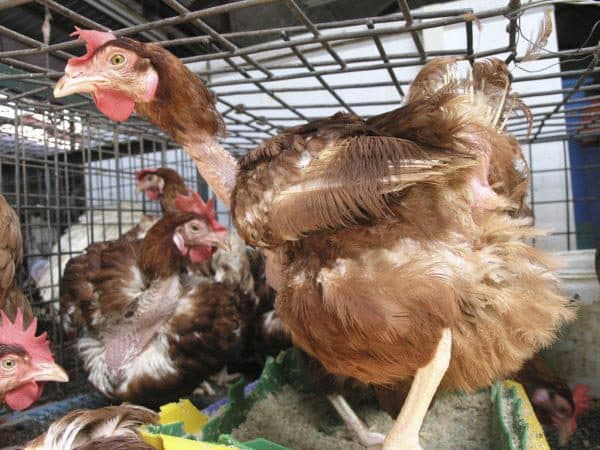

The threat of this parasite consists not only in the ugly appearance of a chicken, which remains without beautiful feathers, but in winter it can quickly freeze.
This is not the only breeding ground for parasites, because they can function on bedding, elements of the chicken coop, including any inventory items made of wood. Such a parasite can easily be transmitted to another animal by touching an infected individual or as a result of contact with any object where the pest lives. But how you can use tobacco dust from pests and how effective it is, is indicated here.
Thus, the appearance of a feather eater brings only losses, because, in addition, chickens can refuse food, they are depleted. In the absence of proper care, an infected chicken may soon die. In addition, the existence of the parasite affects the functional abilities of birds, because chickens stop laying eggs. But what can be done when birds fall to their feet and what diseases can contribute to this, this article will help to understand.
The parasites have a light brown or yellowish body of a slightly compressed and elongated configuration. There are two pointed claws on the legs, with the help of which they cling to the feather or skin of chickens. Also, insects damage feathers for a short time, so it is so important not to miss the moment of identifying the parasite. You will also be interested to learn about how mycoplasmosis is treated.
Symptoms that indicate the presence of a parasite:
- defect of feather shafts at the root with holes;
- the infected bird becomes agitated, regularly tries to get under the feather with its beak;
- with prolonged infection with chewing lice, part of the plumage disappears in chickens, zones of the dermatological cover are exposed;
- diseased birds lose weight, and in addition, egg laying decreases.
The reason for the loss of feathers in poultry is not always the chicken feather, sometimes it is a natural molt, and therefore, before starting treatment and choosing a method of dealing with the feather eater,you need to be sure of the presence of these parasites.
We suggest you familiarize yourself with: How to get rid of cockroaches in the microwave
Symptomatic picture of feather mite infestation:
- The plumage loses its shine and begins to bulge.
- Restless behavior of the bird - itches and sways in the dust.
- Baldness in the anus and neck.
- Birds are restless, and fights become more frequent.
- Rapid weight loss.
- Cases of pecking are increasing.
- Layers often change the place of laying eggs, egg production drops.
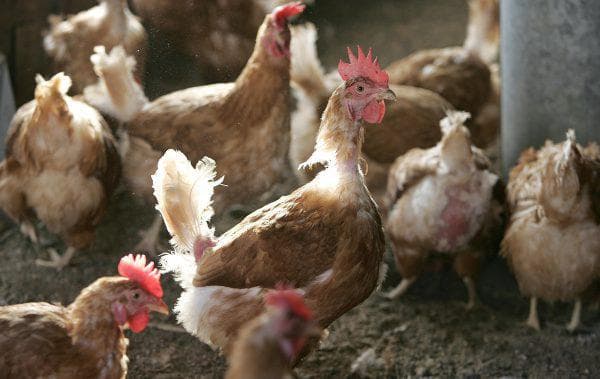

There are also ways to determine the presence of infection during examination:
- Outwardly, Mallophages resemble a flea. The parasites look like this: the length is up to 2 mm, the body is brown-yellow, the head is larger than the chest, these ticks are agile and move quickly between the feathers.
- The feathers that the downy eaters feed on have a thinned base, a specific hole is formed at the place of loss, gnawed out.
- Chicken often itches, so small wounds, like abrasions, will form on the skin under the feathers.
Downy eaters affect birds of all ages, but young animals especially suffer from them. Sick chickens, care items and equipment are the source of lice. Birds can become infected through cages, perches, nests, dust baths.
In the photo - baldness on the back indicates a neglected situation with chicken lice.
Roosters play a significant role in the spread of malofagi. It was noted that the number of parasites on roosters is significantly higher than on chickens. This is due to the fact that males pay less attention to cleaning the plumage and rarely use dust and sand baths.
The peak of the disease usually occurs in the spring or fall.
Crowded content, poor care, poor diet and dampness in the poultry house contributes to mallophagoses.
Compared to mammals, birds are more severely affected by the disease. Signs of parasitism on downy eater chickens will be the following manifestations.
- Lice do not like light, therefore they hide in secluded places - under the wings, in the near-anal region, on the lateral and lower parts of the body. Sometimes it is quite difficult to see them, as they are able to adapt to the color of the host's plumage. With a high number of feather-eaters, chickens become bald, more often feathers fall out on the back, belly and neck.
- If you carefully examine the feather, you can find holes in it, which the parasite eats away as it moves through the body of the bird.
- Several types of parasites can parasitize on one chicken at once, they accumulate in different places. Some downy eaters affect the feathers in the head and neck area, as a result of which the skin in these places becomes bare. Parasites also affect the eyes, there are outflows from the eyes and inflammation (kerato-conjunctivitis) develops.
- Chicken lice prefer young feathers. Therefore, during the molting period, the symptoms of the disease are aggravated.
- Chickens are restless, constantly rummaging in plumage, can peck at themselves, pluck out a feather.
- With a strong degree of invasion, abrasions and injuries, particles of exfoliated epithelium, crusts of dried blood and exudate, excretion of parasites and their eggs are visible on the bald skin. Similar signs can be seen on the crest and earrings.
- A decrease in live weight, a drop in egg production are noted.
The diagnosis is made when feather eaters and their eggs are found on the body of a bird. To facilitate inspection, the bird is placed in direct sunlight for 5-10 minutes or warmed up with a lamp. Parasites creep out into the heat and become well visible.
Lice cannot be found on a dead bird, because they move from a cooling corpse to more favorable habitats.
Mallophagoses must be distinguished from skin diseases caused by microscopic mites (scabies). For this, it is necessary to examine the scraping of the upper layer of the skin under a microscope for the presence of mites.
Preventive measures
An important role in the fight against parasites is played by the implementation of all preventive measures:
- regularly change the flooring, remove chicken droppings every two days;
- once a month, carry out a complete disinfection of the chicken coop, including drinkers, feeders and tools;
- hang bunches of herbs around the perimeter of the poultry house, the aroma of which cannot be tolerated by parasites, and change them regularly;
- you need to monitor the behavior of birds, this allows you to recognize the onset of the disease in time;
- when confirming the infection of birds with a feather-eater, it is necessary to immediately begin to combat it, as well as to disinfect the premises;
- make sure that the chickens do not have contact with wild birds flying in for walking;
- if the owner entered another room with poultry, it is necessary to change clothes, shoes, wash your hands.


Compliance with preventive measures allows you to avoid mass destruction of the chicken livestock by a feather or a down-eater. The main thing is to keep the house clean and ventilate it regularly.
We have told you how to get rid of feather eaters from chickens.

